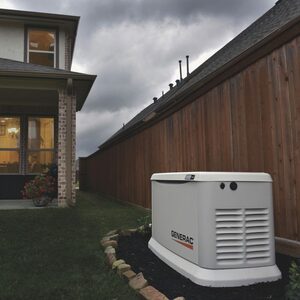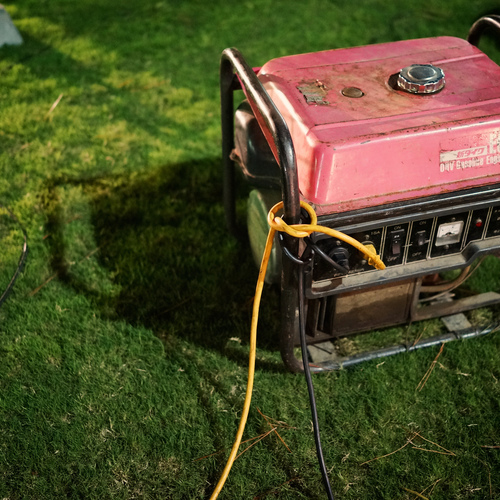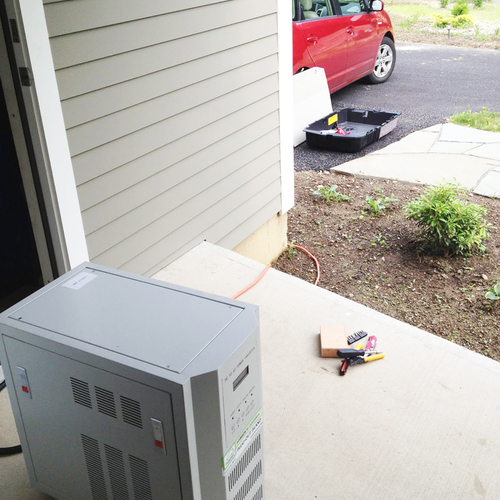
What could possibly go wrong? With that tongue-in-cheek question, a GBA reader named gstan wonders where money is best spent in a season when the threat of power outages looms large.
“As I write this, the news headlines are all power outages and deaths caused by those outages (all a result of unanticipated weather conditions),” gstan writes in this recent Q&A post. “Murphy is once again right: Anything that can go wrong will go wrong, and at the worst possible time. It’s Christmas, the coldest weather in 50 years sweeps across, the power grid goes down in various States from Texas to Maine—heat pumps, all electric devices (not battery powered), even gas-powered furnaces controlled by electricity all go down.”
This leads gstan to a central question: Does it make more sense to spend money on the latest high-tech devices and gadgetry, or on adding more insulation when designing and building a house.
“It’s actually difficult to find many scenarios where better insulation is likely to fail,” gstan says.
That’s where we start this Q&A Spotlight—more money for hardware and equipment, or more money upfront on insulation?
Actually, we need both
Ohioandy doesn’t think it’s an either-or question for people living in colder parts of the country.
“Adding more and better insulation can’t be done without also relying on high-tech powered gizmos to help us actually survive in that cozy shell,” he says. Survival, let alone comfort, relies on ventilation, windows, lighting, and heating, and a lot of that can’t be accomplished passively.
“But yeah,” he adds, “resiliency is a top-of-mind concern for most of us here, and this bomb cyclone exposes one set of weaknesses.”
Power outages rarely affect the whole grid
Notwithstanding the fact that most power…
Weekly Newsletter
Get building science and energy efficiency advice, plus special offers, in your inbox.

This article is only available to GBA Prime Members
Sign up for a free trial and get instant access to this article as well as GBA’s complete library of premium articles and construction details.
Start Free TrialAlready a member? Log in















9 Comments
Although not exactly a green answer - we got through a week long power outage in Michigan (in the summer) with a 1000watt inverter and our vehicles. Cycled idling to charge the battery and then let it discharge a bit. Not great for a lead acid battery, but it did the job. Usually outages only last 6-12 hours, so when the power went out, I didn't think much of it. Next morning and it seemed like there was no chance it was going to be back anytime soon... Generators of course all get sold out immediatly. So I went to autozone and spent $100 on an inverter. It was enough for some light, the fridge, and to charge our phones and laptop while I worked from home. Since then I have gotten a 5000 watt generator. I still am not able to run my furnace on that, but I've also never lost power in the cold winter.
We went this route and it worked really well with our older electric car. You take power off the small 12v battery and the larger car battery recharges it. We charged phones, kept our fridge running and made coffee for the 3 days our power was out. It's nice that you can leave the car on without draining the battery much, though there is some constant load from the car. One challenge is having a full charge when the unexpected happens, especially if you use charging timers to take advantage of nighttime rates.
We have a woodstove which was handy because our heating is electric...however, because the place is well insulated and airsealed, we could have coasted at manageable temps, especially in our mild climate (Northern CA). That being said many of our friends in conventional homes were pretty uncomfortable...but it wasn't life threatening.
As long as we're still allowed to have wood stoves and pellet stoves, we have an "out" for heating when the power goes out. But I fear that "those who know what's best for us" may eventually ban them, too (!)
Using a PHEV as a small-scale generator is clever. My next vehicle will probably be a PHEV.
We were very happy to have the comforts we did. Regarding woodstoves, we have "spare the air" days where burning is prohibited based on air quality measures. Folks that use woodstoves as their primary source of heat are exempt. Seems like a good system for an urban area as outdoor air quality can be a problem here.
"...an all-electric home will typically need a larger generator. That will cost more to install (but not a lot more)..."
Maybe, but that assumes you are allowed to have a gas generator, presumably NG if we are talking "installing". And wood and pellet stoves are increasingly coming under "ban" scrutiny as well. I understand that WA state is mandating no NG appliances in new building, and in any case it makes no sense to maintain a gas account just for a rarely-used generator. My gf in Bellingham WA put in a 13kW NG Generac last year after a 27 hour outage, at a cost of $15k. She has an older house with a condensing boiler and HW baseboards.
Most heat pumps run on 220v so you need to be sure the genny will provide 220 as well. Gasoline gennies like Honda are really good but storing gasoline is a problem. Diesel gennies are great but expensive and should be kept "loaded" at about 60-70% of rated power most of the time in order to burn cleanly.
My present house, is well insulated (although window performance could be better), heated by a condensing boiler and HW baseboards. When we had an 84-hour outage in an ice storm a few years ago, my modest battery backup system could run the essentials, including the boiler, for about 4-6 hours, then my c.1960 Onan 6kW diesel genny would recharge the batteries for a couple of hours and run the house. The neighbours even came over to have a shower at one point. And I didn't have to run the genny continuously.
I also have a pellet stove, which came in very handy last December when the boiler sprang a leak and I was w/o heat or HW for 2 days and the outside temp. was 12ºF at night! Hardly a really "green" setup but I could keep comfortable.
The "all electric" future is dandy as long as you have - and can afford - a suitable Plan B. I will probably be moving in the next 4-5 years and will want a battery backup system, but powering a heat pump system will be problematical unless the power requirements for heat pumps can be significantly reduced.
Battery back-up is still very pricey and if you have rooftop solar, it may not be able to charge your batteries. A Tesla Powerwall only stores about 12-13 kwh.
We have an all electric house and a 7000 watt Honda gasoline generator. It works well and, if we don't run everything at once, can power even the electric stove. Our two heat pumps are on 15 amp/240 volt circuits and we keep both on, as well as the well pump, lights, HPWH and the usual stuff. It plugs into a receptacle wired into the panel, which has a metal plate that only allows generator power to turn on if the main breaker if off.
As for gasoline, every couple of months I dump it into one of our vehicles and get new. We store 15 gallons in a garden shed. The generator only uses around 1/2 gallons per hour. We shut it off at night. It's a reasonable solution.
Battery backup - at least anything that we mortals can afford - is utterly inadequate for such purposes. And forget lithium ion, for that very reason. My system has 4 x L16. If/when I move I'll probably double that to 8 in parallel. There are some new battery types being worked on but they'll probably be equally pricey. There is still the problem with lithium batteries as to local/regional recyling, although this is being improved as well.
My neighbour up the street also went with a v. nice Honda gas genny and like you, he uses it in his car and buys fresh, adding Sta-Bil. I do the same with my diesel genny as I have a small diesel tractor and excavator, and refill the plastic 20L cans from the 100L (~26 USG) steel tank. Diesel is a lot safer to store, though, and lasts longer. And of course, I have a transfer switch to isolate from the utility line when running the genny (!) I think my generator uses about the same amount of fuel as yours, but only having to run it every 4-6 hours during an outage, I'm good for about 6-7 days. The local Co-Op has their own genny so as long as they can get fuel delivered, I can refill there.
No matter what system we use, though, it is VERY good to have it and I we just have to muddle through the options as best we can.
One interesting option is to buy a Plug-in hybrid electric vehicle (PHEV) car/truck that can double as a modest power generator for a power outage. For pre-2023 Prius Prime PHEV you can use an 120v pure sine wave inverter up to about 1,000 watts. NYT has a story where a homeowner ran his house on a 2010 or so Prius for a week.
A mini split, refrigerator and lights with 120v output will run off this car for a week or more with a full tank of gas if used carefully.
The new 2023 Prius Prime PHEV has two 120v outlets in the rear of the car.
When running the car is very low noise and much cleaner than a stand-alone generator.
These PHEV will sit quietly providing 120v until the Traction Battery runs low and then starts and runs for a short time to recharge it. Park the car with the tailpipe away from the house. Supper efficient generator with very low emissions and noise.
When not using it for emergency power you can drive it like we do and get upwards of 85 mpg on the highway, generally, 65 mpg is the norm. We use about 1 or 2 tanks of gas a year and most of our trips are on EV mode for up to 25 miles.
We have a passive solar house (we designed and built 1986) and noticed that the coldest days are the clear sunny days and heat up the house with no need for additional heat source. We have above-average insulation including insulating curtains and tight construction, low E windows and most of the windows to the south with 2 foot overhangs for summer shading.
We have very low energy bills currently.
Have two Ebikes for the vast majority of trips we take. Saves lots of energy, money and health.
Hope to add solar and batteries this year, and with government rebates makes it much more affordable. In Mid-Michigan the utility, DTE, pays very little for green power added to the grid and then sells it for a major premium, not a good system. Adding heat pumps also get rebates as well as electrical upgrades for this. The state rebates may take a little time to get up to speed this year but many states will provide them.
vpc2,
After reading your post I began poking around. There are even people buying wrecked hybrid Priuses to convert into home generators. There are a lot of intriguing possibilities.
Log in or become a member to post a comment.
Sign up Log in